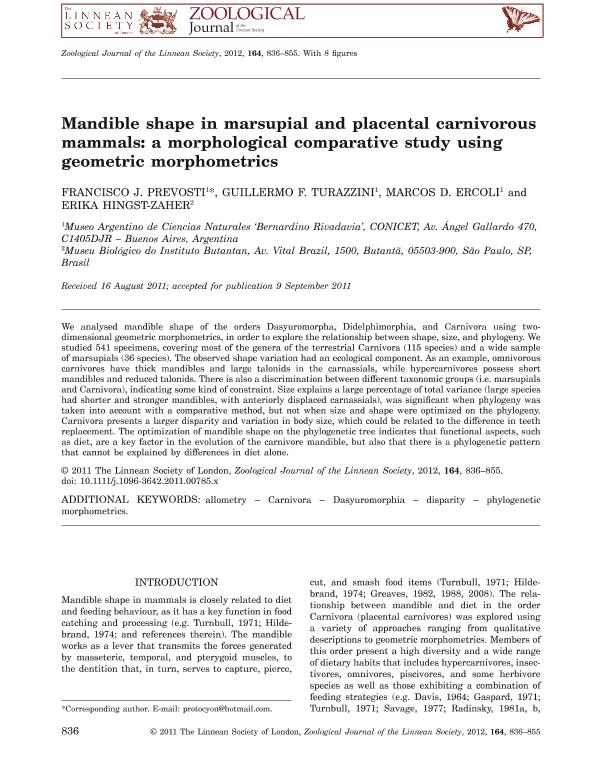Artículo
Mandible shape in marsupial and placental carnivorous mammals: a morphological comparative study using geometric morphometrics
Fecha de publicación:
09/04/2011
Editorial:
Wiley Blackwell Publishing, Inc
Revista:
Zoological Journal of the Linnean Society
ISSN:
0024-4082
Idioma:
Inglés
Tipo de recurso:
Artículo publicado
Clasificación temática:
Resumen
We analysed mandible shape of the orders Dasyuromorpha, Didelphimorphia, and Carnivora using twodimensional geometric morphometrics, in order to explore the relationship between shape, size, and phylogeny. We studied 541 specimens, covering most of the genera of the terrestrial Carnivora (115 species) and a wide sample of marsupials (36 species). The observed shape variation had an ecological component. As an example, omnivorous carnivores have thick mandibles and large talonids in the carnassials, while hypercarnivores possess short mandibles and reduced talonids. There is also a discrimination between different taxonomic groups (i.e. marsupials and Carnivora), indicating some kind of constraint. Size explains a large percentage of total variance (large species had shorter and stronger mandibles, with anteriorly displaced carnassials), was significant when phylogeny was taken into account with a comparative method, but not when size and shape were optimized on the phylogeny. Carnivora presents a larger disparity and variation in body size, which could be related to the difference in teeth replacement. The optimization of mandible shape on the phylogenetic tree indicates that functional aspects, such as diet, are a key factor in the evolution of the carnivore mandible, but also that there is a phylogenetic pattern that cannot be explained by differences in diet alone.
Palabras clave:
ALLOMETRY
,
CARNIVORA
,
DASYUROMORPHIA
,
DISPARITY
,
PHYLOGENETIC MORPHOMETRICS
Archivos asociados
Licencia
Identificadores
Colecciones
Articulos(MACNBR)
Articulos de MUSEO ARG.DE CS.NAT "BERNARDINO RIVADAVIA"
Articulos de MUSEO ARG.DE CS.NAT "BERNARDINO RIVADAVIA"
Citación
Prevosti, Francisco Juan; Turazzini, Guillermo Fidel; Ercoli, Marcos Darío; Hingst Zaher, Erika; Mandible shape in marsupial and placental carnivorous mammals: a morphological comparative study using geometric morphometrics; Wiley Blackwell Publishing, Inc; Zoological Journal of the Linnean Society; 164; 4; 9-4-2011; 836-855
Compartir
Altmétricas




